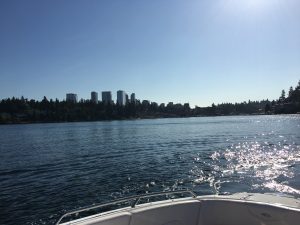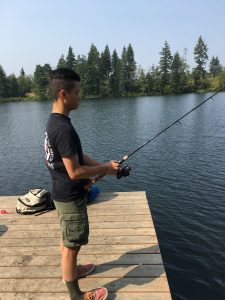Lake Washington yellow perch are abundant and an excellent late-summer fish to catch Leave a reply
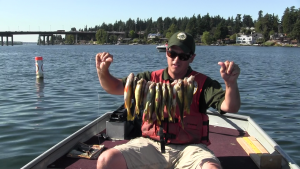
Danny Garrett, the state Fish and Wildlife warm-water biologist, holds up a nice stringer of yellow perch he caught on Lake Washington. These later-summer fish are an easy catch and very abundant in the lake. Photo courtesy of Danny Garrett.
By Mark Yuasa
The yellow perch in Lake Washington are one of the most prolific fish species in Lake Washington, and for anglers they’re easy to find and extremely fun to catch.
“I recently took our marketing team out to fish for them, and we caught around 200 and never left our one spot,” said Danny Garrett, the state Fish and Wildlife warm-water species biologist.
“We caught a bunch in 8- to 10-inch range along with a couple over 10 inches,” Garrett said. “It is just so easy to catch them at this time of the year. I get super excited every August and can never talk enough about the perch fishery.”
Those sizes of yellow perch that Garrett and his group caught are typical of the catch in Lake Washington although a “jumbo-sized” fish of 12 inches or longer can often be found mixed into the schools of fish.
State fisheries experts say it is only a matter of time before the official state record of 2.75 pounds caught by Larry Benthien at Snelson’s Slough in Skagit County on June 22, 1969 could be broken, and it likely may come from Seattle’s backyard urban watershed.
The basis for this statement is largely based upon the ample feed and lots of room for yellow perch to grow in Lake Washington – the second largest natural-bodied lake in the state.
“I don’t think we can keep up with the recruitment of yellow perch in Lake Washington, and even with the amount of fishing pressure we won’t make a dent on the population,” Garrett said. “The survival rate of perch are doing very well, and I’ve been doing surveys on the lake, and they dominate all the other warm-water fish species.”
Yellow perch – known for their colorful yellow, orange and brass-colored bodies with distinct olive-green, vertical triangular bars along each of their sides – spawn in April, and well ahead of many other warm-water fish species in the lake.
The female perch are the largest, and they tend to grow much faster (usually maturing in three to four years) and live long up to 8 to 10 years.
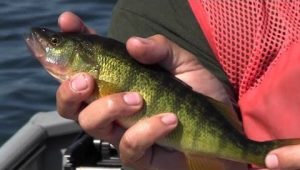
Yellow perch are the most abundant fish species in Lake Washington, and are very willing to take an anglers bait all-day long. Photo courtesy of WDFW.
“Unless we get a high die-off due to some type of fungal infection, I think they will be with us for a very long time in the lake,” Garrett said.
Perch won’t peel off line or leap out of the water like a salmon, but an all-day virtual nonstop bite will get any angler hooked on this enjoyable late summer and fall fishery.
‘On the day we fished it, we hung out in the Newport Canal and along the Newport Shores area just south of I-90,” Garret said. “There was 100s and 1,000s of perch schooling in the area, and when we’d reel in one you’d see 50 more perch chasing them up to the surface. It was amazing.”
Since the lake is huge – 20 miles long and covering more than 22,000 acres – it can seem a bit daunting to the newbie, but there are some simple tips to follow to find excellent success to catching yellow perch.
The best time to fish for yellow perch begins around July when the water heats up, and peaks in August through October. As the winter chill sets in by November, the bite all but ceases as the perch move out into very deep water.
Look for schools of yellow perch in shallow water, 15 to 35 feet, and close to the shoreline. They tend to hang in shaded spots just outside the cover of weed beds, milfoil, aquatic weeds and lily pads or under docks, piers and overhanging trees and brush.
“The fish feed throughout the day on snails, clams, crayfish and smaller invertebrates, and are a lot more active even in middle of afternoon and only hunker down at night when predators are out,” said Garrett who claims even during broad daylight they aren’t spooked by boaters or jet- or water-skiers zipping around.
“When we fished it a couple weeks ago they were active from 11 a.m. until we quit at 3 p.m.,” Garrett said. “You don’t have to be out there fishing early in the morning either. I also visited a bunch of piers and shorelines recently, and saw guys catching them right next to busy swim areas.”
Places to catch and gear to use for yellow perch
Popular locations to catch perch are Seward Park; Kenmore log boom and pier; Magnuson Park shoreline; Andrews Bay; Juanita Bay; Newport area; Webster Point in Union Bay; Yarrow Bay in Kirkland; Gene Coulon Park in Renton; Foster Island just outside the Montlake Cut; Mercer Island; and the docks off Madison Park, Stan Sayres Pits, Leschi Park and Mount Baker Park.
The gear to catch them is relatively simple using a light-to-medium-action fishing rod with a spinning reel attached to 4- to 6-pound test line.
“I keep two simple no-brainer options in the boat to catch perch, and while perch meat is awesome I haven’t gone in that direction,” Garrett said. “I use earth worms and a drop-shot (egg-style) weight, which is much easier than the three-way swivel technique. I will also use (Sniper Lures) Sniper Snubs – a colorful tiny 3-inch plastic worm. You really have to feel the very subtle strikes these fish make, and often the bigger 10- and 12-inch fish will just nibble at the bait, and are more finicky biters. Don’t set the hook hard when you first feel them bite, play with them a little bit and they’ll eventually strike the bait.”
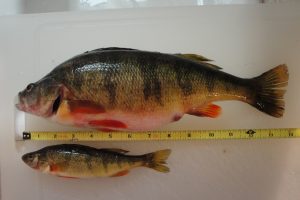
The difference between an 8-inch and 14-inch yellow perch show the growth potential in Lake Washington. Some experts say the next state record could come from Seattle’s largest urban watershed. Photo courtesy of Danny Garrett, WDFW biologist.
Others will also use a skirted crappie jig, maggots and like previously mentioned by Garrett a small chunk of perch meat or even a perch eyeball works well.
While the main focus in Lake Washington are yellow perch the wide diversity of fish species enables an angler to switch gears and catch cutthroat and rainbow trout, smallmouth and largemouth bass and black crappie along with another abundant fish the “rock bass” a species of the sunfish.
“There are more rock bass showing up than in previous years, and guys are catching a lot of them,” Garrett said. “In places like the Ship Canal we have seen a 50-50 split of yellow perch and rock bass. They aren’t big on eating, but very fun to catch.”
Lake Washington isn’t the only yellow perch show in town, and good action can be found in lakes Sammamish; Beaver and Pine near Issaquah; Whatcom near Bellingham; Sawyer northwest of Black Diamond; Goodwin northwest of Marysville; Stevens east of Everett; American near Fort Lewis; Kapowsin southeast of Puyallup; Angle in Sea-Tac; Desire in Renton; Meridian in Kent; and Harts southeast of Yelm.
Yellow perch are also very tasty with a firm white-fleshed body.
“I would call them the little walleye and they’re actually related,” Garrett said. “They’re in the same wheelhouse in texture and flavor as a walleye, and I’d eat them all-day long.”
State Fish and Wildlife doesn’t have a daily catch or size limit on yellow perch in the majority of statewide lakes, but check the regulation pamphlet before heading out to fish for them. You can also find plenty of information on yellow perch, including a super great video with WDFW’s Danny Garrett by going to the link http://wdfw.wa.gov/fishing/washington/Species/1849/.
Mark Yuasa
Outdoor Line Blogger
710 ESPN Seattle


